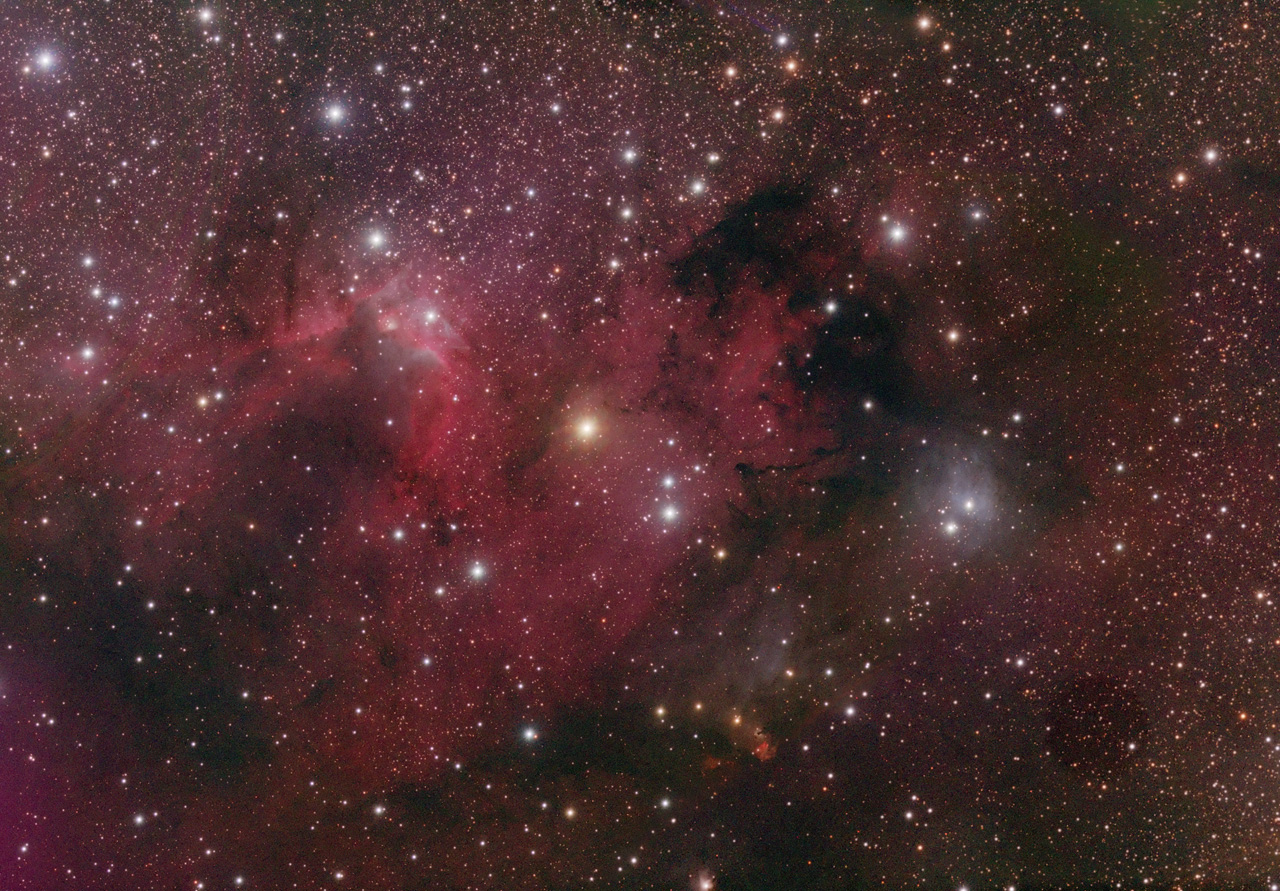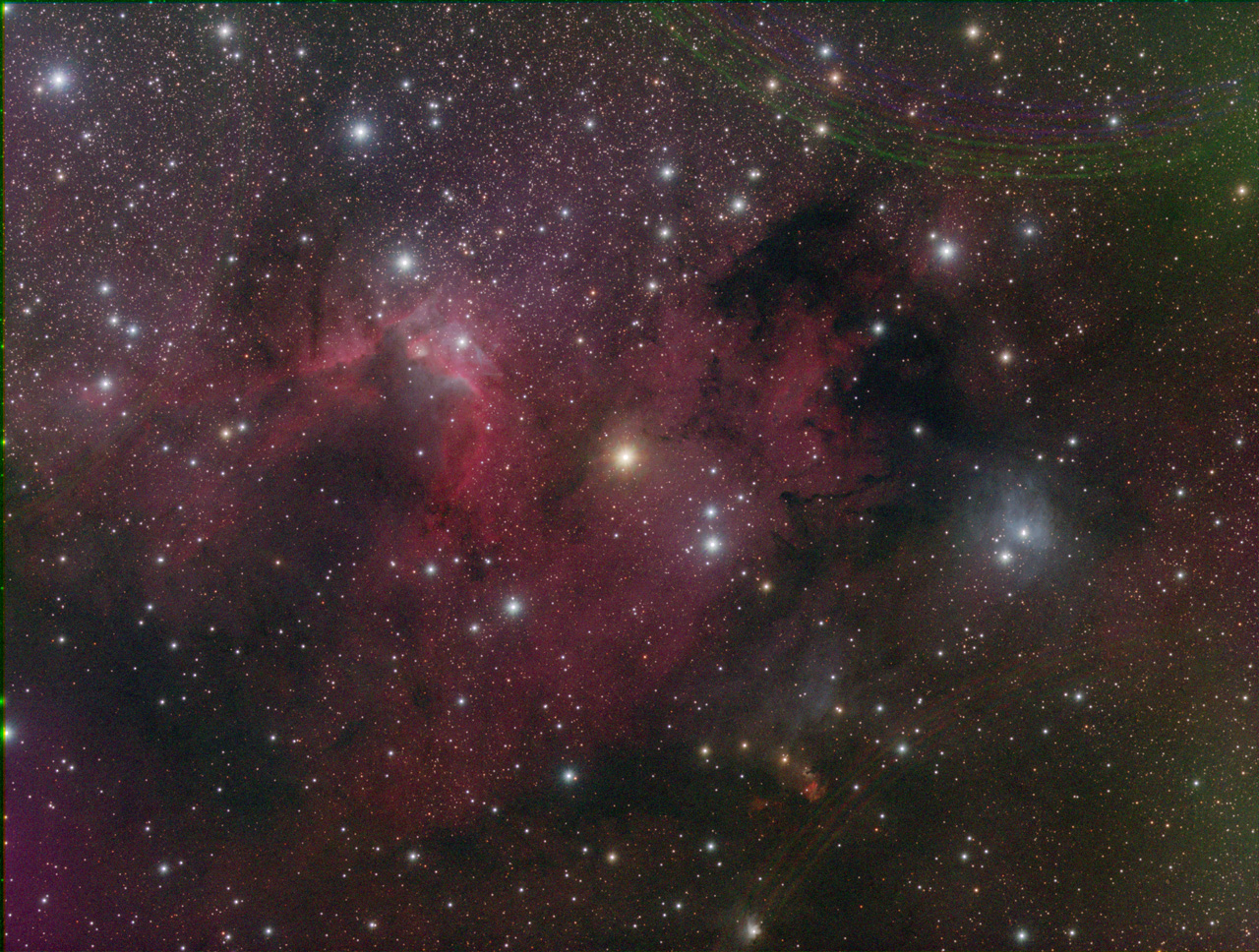This past weekend we had a New Moon and, surprisingly for this late in the year, good weather. So I went to my favorite dark sky site, SkyView Acres, in Goldendale, WA. I don’t think I’ve ever gone to a star party this late in the year. My primary goal was to get some good RGB data of the Cave Nebula to go with the narrowband data I captured recently from home.
The first night was great, although a bit cold. I was getting some of the sharpest images I’ve had in this area, with an average FWHM of 2 arcseconds and some frames as good as 1.8 arcseconds. Unfortunately, while capturing these frames I could not see (in the individual sub-exposures) that some kind of internal reflection was messing with the images. When I processed them the next day I got this:
Notice the multi-colored arcs in the upper right and lower right. This was the same thing that ruined my RGB exposures at the same site a month earlier, although it was worse then. I thought the problem had gone away because the narrowband images did not show these arcs at all, but I guess that was just wishful thinking.
I spent the next 2 nights experimenting (unsuccessfully) with various ways to eliminate the extraneous lines. I managed to reduce their intensity quite a bit, but not completely eliminate them. Indeed, reducing their intensity meant that it was even harder to detect them in individual frames, making me think I had solved the problem when I hadn’t really.
These 2 nights were both windy, and I was no longer getting sharp images, but captured them anyway because I figured I could use the data to “fill in” where the lines appear in the images from the first night. It was also very cold both of these nights. The good thing about imaging this time of year is that you can do 4 hours or so of capture before midnight, then go to bed. In the middle of Summer there is only 4 hours of good darkness in the whole night, and you have to stay up all night to make use of it.
I continued the experiments (and sought ideas from colleagues) after returning home. The lines seem to be caused by internal reflections – probably at the back end of the imaging train. I was able to reduce the intensity by moving the prism of the off-axis guider farther out from the image center, but that may have been a red herring. Something I haven’t yet tried is to completely remove the OAG. I did swap the RGB filters for an older set, which made very little difference, and added a black mask over the sensor to avoid having light fall on parts of the sensor chamber that are not otherwise masked. This made no difference.
A really confusing aspect of this problem was that there are no super-bright stars nearby the Cave to provide light for these reflections. Eventually, I got around to testing for the source of the light by jogging the telescope to slightly different angles. This caused the arcs to move a bit (within the image frame). The brightest star in the image is the yellowish one near the center, but this does not seem to be the source because moving to place a very bright star in the center did not produce any reflections. There is some evidence that the problem is with the filters, and other, equally good evidence saying it has nothing to do with the filters.
What I ultimately did is to move the ‘scope to the right quite a bit (so the stars in the image move left), which caused the reflections to move in the opposite direction, and eventually disappear. This revealed a somewhat brighter star off the lower right corner of the original image, but it does not appear to be the source of the reflection.
Although I still haven’t figured out what is causing the reflection, I was able to combine the “shifted” image with the original image, erasing the bad spots in the original to replace it with the data from the shifted image. The replaced portions of the image are not as sharp as the original, but this is not apparent to the viewer – especially when the image is reduced in size, as it is here.
The next step for this image is to see if I can combine it with the narrowband image to make something better. I will also continue trying to figure out what causes the reflections, but I think it’s time to get more suggestions from others on that.

